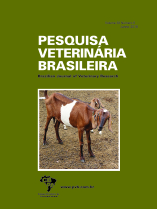 |
|
|
|
Year 2018 - Volume 38, Number 6
|

|
Goiter in cattle, 38(6):1030-1037
|
ABSTRACT.- Martins K.P.F., Fonseca T.R.S., Silva E.S., Munhoz T.C.P., Dias G.H.S., Galiza G.J.N., Oliveira L.G.S. & Boabaid F.M. 2018. [Goiter in cattle.] Bócio em bovinos. Pesquisa Veterinária Brasileira 38(6):1030-1037. Hospital Veterinário, Faculdade de Medicina Veterinária, Universidade de Cuiabá, Rua Itália s/n, Jardim Europa, Cuiabá, Mato Grosso, MT 78015-480, Brazil. E-mail: fabianaboabaid@hotmail.com
Goiter is a non-inflammatory and non-neoplastic enlargement of the thyroid gland in adults and neonates. One of the main causes involved is the nutritional deficiency of iodine. In this study three outbreaks of goiter in cattle are reported. In the first outbreak (Farm A) 60 calves were affected, of which 20 died soon after birth, 30 recovered and 10 remained sick. In the second outbreak (Farm B) a cow and its fetus were affected and in the third outbreak (Farm C) two calves were affected. The main clinical signs observed were bilaterally enlarged thyroid glands, weight loss, respiratory distress, hypotrichosis and myxedema. Additionally in the Farm A abortions were reported. Macroscopically the thyroid of the calves and fetus was enlarged, dark red with evident vascularization and cervical subcutaneous edema. In the Farm B the cow showed enlarged thyroid gland as well. Microscopically the calves and the fetus had hyperplastic and heterogeneous thyroid follicles with absence of colloid and vascularized interstitium. The thyroid of the cow was also hyperplastic, but had higher amount of colloid. In all outbreaks the mineral supplementation was performed by mixing non-iodized white salt with the mineral mixture. On the property A the white salt was non-iodized and mixed in equal parts with the mineral salt. At property B the salt was also mixed to a non-iodized white salt in ratio and 1:2, respectively. In the property C, mineral salt and non-iodized white salt were offered in separate troughs in the field, and according to the owner’s report the animals prioritized the consumption of white salt. In all the monitored properties it was recommended to stop the addition of white salt in the mineral mixture and the administration of iodine to the affected calves. After these measurements no new cases were observed in the properties. Despite being a well-known disease, there are still few reported cases of goiter in cattle in Brazil. Moreover, little is known about the actual mineral deficiencies of each region, and that simple nutritional management guidelines are still needed. |
| |
|
|
| |
|
 |